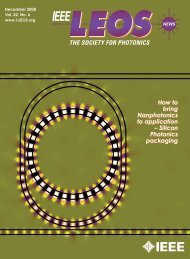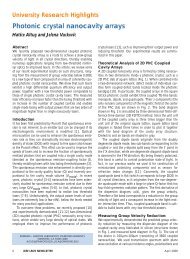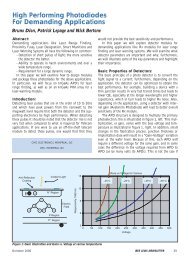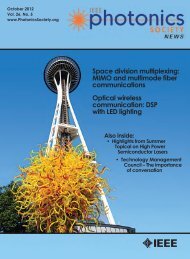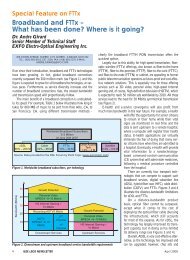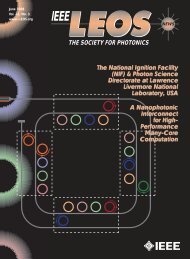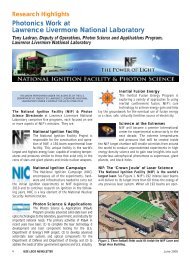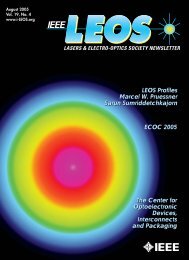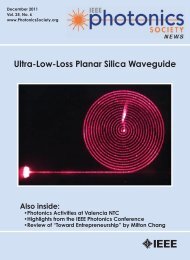Long-Period Fiber Gratings as Band-Rejection Filters
Long-Period Fiber Gratings as Band-Rejection Filters
Long-Period Fiber Gratings as Band-Rejection Filters
You also want an ePaper? Increase the reach of your titles
YUMPU automatically turns print PDFs into web optimized ePapers that Google loves.
βcl 2 + κ2 = ω2 n 2 cl<br />
(2)<br />
c 2<br />
where n cl is the refractive index of the cladding. Assuming a<br />
simple step-index profile, the axially symmetric cladding<br />
modes that are nonzero at the origin are described by Bessel<br />
function of order zero, namely, J 0 (κ a cl ) where a cl is the<br />
cladding radius. The difference in the wavelengths at which<br />
the guided mode couples to the different cladding modes, δλ,<br />
correspond to the separation of the zeros of the Bessel function<br />
[13]. Since the difference in the zeroes of J 0 (x), denoted by<br />
δx 0 , can be approximated by δx 0 ≈ π [14], the δλ’s will correspond<br />
to the condition κ a cl = πp where p is an integer. The<br />
expression for δλ is obtained in an indirect manner, <strong>as</strong> follows.<br />
We first find the separation in wavelength between the<br />
pth-cladding mode and λ cut . Using (1) and (2), we arrive at the<br />
expression<br />
λ p λ 2 cut<br />
(λ p − λ cut ) ≈<br />
8n cl (n eff − n cl ) . p2<br />
a 2 (3)<br />
cl<br />
where n eff is the effective index of the guided LP 01 mode<br />
(β 01 = 2πn eff /λ). In deriving (3), we have <strong>as</strong>sumed that the<br />
effective index of the fundamental mode at λ p and λ cut is the<br />
same. For an AT&T DSF, this approximation leads to an error<br />
< 2%. For the first few cladding modes one can further simplify<br />
the expression by <strong>as</strong>suming that λ p and λ cut are in close<br />
proximity. The wavelength separation between the pth and the<br />
(p + 1)th-mode can then be approximated by<br />
λ 3 cut + 1)<br />
δλ p, p+1 ≈<br />
.(2p<br />
8n cl (n eff − n cl ) a 2 . (4)<br />
cl<br />
As an example, we consider a DSF with a long-period grating<br />
with the following properties: = 550 μm, λ cut = 1.41 μm<br />
and predict the wavelength separation between the first two<br />
cladding modes δλ 1 to be 65 nm. Our experiments show that<br />
the separation of wavelengths between the first and second<br />
modes, δλ 1 for the above example is 57 nm.<br />
The spectral dependence of the grating transmission can be<br />
approximately determined by using expressions derived in the<br />
literature [15] for codirectional mode-coupling. The ratio of<br />
power coupled into the nth-cladding mode to the initial power<br />
contained in the guided LP 01 [ mode √ is then given ] by [16]<br />
( ) 2<br />
sin 2 κ<br />
P (n)<br />
g L 1 + δ<br />
κ<br />
cl<br />
(L)<br />
g<br />
P 01 (0) =<br />
where δ is the detuning parameter<br />
δ = 1 2<br />
( ) 2<br />
(5a)<br />
1 + δ<br />
κ g<br />
{<br />
β 01 − β (n)<br />
cl<br />
− 2π }<br />
<br />
(5b)<br />
κ g is the coupling constant for the grating and L is the grating<br />
length. The coupling constant κ g is proportional to the UVinduced<br />
index change and is typically incre<strong>as</strong>ed to maximize the




